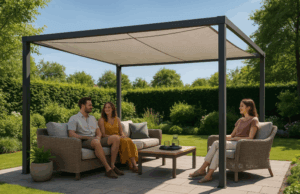
The Ultimate Eco Garden Setup: Tips for a Sustainable Outdoor Space
Building an eco-friendly garden isn’t just about pretty plants. It’s about creating a space that’s good for the planet, easy to care for, and healthy for you and your family. The best part? You don’t need to be a pro gardener to make it work. A simple touch, such as adding a garden shade canopy, can protect your plants and help reduce water loss, too.
Here are easy, smart tips to help you set up your own sustainable garden—no fluff, just honest advice that works.
1. Start with the Soil
Healthy soil is everything. It’s where your plants live, grow, and get their nutrients.
- Compost: Use food scraps, grass clippings, and leaves to create your own compost. It adds nutrients and cuts down on waste.
- Skip chemicals: Avoid synthetic fertilizers and pesticides. They hurt the soil and pollute water.
- Test your soil: Local garden centers often offer test kits or services. Knowing what your soil needs helps you grow better plants.
👉 EPA recommends composting as one of the top ways to reduce household waste and enrich soil naturally.
2. Use Native Plants
Native plants are built for your local climate. That means less watering, less care, and fewer pests.
- Why it matters: These plants already know how to thrive where you live.
- Less maintenance: They need fewer chemicals and less water.
- Help wildlife: Birds, bees, and butterflies love native plants.
🌿 Visit PlantNative.org to find native plant suggestions by region.
3. Save Water Like a Pro
Water is a precious resource, especially in dry areas. You don’t need to waste it to keep your garden green.
- Rainwater barrels: Collect rain from your roof and use it to water plants.
- Drip irrigation: Sends water straight to roots with little waste.
- Mulch: Add wood chips, straw, or leaves around your plants to hold in moisture.
💧 According to the EPA WaterSense, homeowners can save up to 8,800 gallons of water a year with smarter irrigation systems.
4. Go Organic and Skip the Plastics
Sustainable gardening isn’t just about what you grow. It’s also about what you use.
- Buy tools that last: Metal tools may cost more, but they outlast plastic ones.
- Plant in natural pots: Clay, ceramic, or biodegradable pots are better than plastic.
- Choose organic seeds: They’re grown without chemicals, and often come from non-GMO sources.
🌱 Pro tip: Look for seed companies that are Certified Organic.
5. Feed Your Garden the Right Way
Not all fertilizers are eco-friendly. Some can damage your soil long-term.
- Make your own compost tea: Mix compost with water, let it sit, and use it to feed plants.
- Use worm castings: Yes, worm poop. It’s one of nature’s best fertilizers.
- Fish emulsion: A natural way to boost plant growth with zero chemicals.
These options nourish your garden without polluting waterways.
6. Welcome Wildlife (the Good Kind)
Your garden can be a home for more than just flowers.
- Add bird feeders or baths: Birds help control pests and add beauty.
- Plant for pollinators: Bees, butterflies, and hummingbirds all play a role in healthy ecosystems.
- Leave a corner wild: A small patch of untamed space helps wildlife thrive.
🦋 Want to build a pollinator-friendly garden? Check out Xerces.org for tips.
7. Design Smart for the Long Term
Think beyond just this season. Plan a garden that grows with you.
- Use permaculture ideas: Layer tall plants, shrubs, and ground cover to mimic natural systems.
- Plant perennials: These come back year after year, saving time and money.
- Zone your garden: Put water-loving plants together and drought-tolerant ones in another area. It makes care easier.
🌎 Sustainability means thinking long-term—not just for your plants, but for your lifestyle too.
What Do Eco Gardeners Actually Use?
Here’s what sustainable gardeners say they use the most:
Data based on sustainable gardening forums and community surveys.
Final Thoughts
You don’t need a huge backyard or a fancy setup. Even a few containers on a balcony can be part of an eco garden. Start with what you have.
Sustainable gardening isn’t just about saving the planet—it’s about building a space that feeds you, calms you, and helps nature at the same time.
Pick one of these tips and try it this week. Then build from there. Every small step matters.